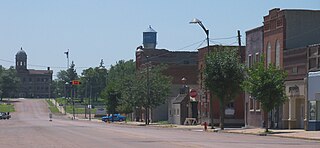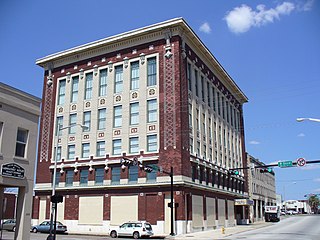
The Masonic Temple is a historic Masonic temple in Jacksonville, Florida. It is located at 410 Broad Street. Constructed by the Grand Lodge between 1901 and 1912, it was added to the U.S. National Register of Historic Places on September 22, 1980.

The Clearwater Masonic and Grand Army of the Republic Hall is a historic building in Clearwater, Minnesota, United States, constructed in 1888. It has served as a meeting hall for both a local Grand Army of the Republic (GAR) post, and a local Masonic Lodge, with commercial space on the ground floor. It was listed on the National Register of Historic Places in 1979 under the name Clearwater Masonic Lodge–Grand Army of the Republic Hall for having local significance in the themes of architecture and social history. It was nominated for its association with the fraternal organizations of Clearwater and many other rural Wright County communities that, in the words of historian John J. Hackett, "provided leadership, direction, and contributions to the county's political, educational, patriotic, and social life."

The Masonic Hall of Hiram Masonic Lodge No. 7 is a historic Gothic revival building on South 2nd Avenue in Franklin, Tennessee. Constructed in 1823, it is the oldest public building in Franklin. It is nationally significant as the site of negotiations leading to the Treaty of Franklin, the first Indian removal treaty agreed after passage of the 1830 Indian Removal Act. It was declared a National Historic Landmark in 1973. It continues to serve the local Masonic lodge.

The Hobart Masonic Hall is a historic building located in the village of Hobart in Delaware County, New York, United States. It was originally constructed in 1889 as a meeting hall for St. Andrew's Lodge No. 289.

The Masonic Temple is a historic Masonic building in Philadelphia. Located at 1 North Broad Street, directly across from Philadelphia City Hall, it serves as the headquarters of the Grand Lodge of Pennsylvania, Free and Accepted Masons. The Temple features the Masonic Library and Museum of Pennsylvania, and receives thousands of visitors every year to view the ornate structure, which includes seven lodge rooms, where today a number of Philadelphia lodges and the Grand Lodge conduct their meetings.

The Montrose Masonic Temple in Montrose, Colorado is a historic building constructed in 1911. Built as a meeting hall for Montrose Lodge No. 63, Ancient Free and Accepted Masons, the building is in the Classical Revival style. The Masons met in the upper two of the building's three stories, while the ground floor was rented out as commercial space. Its commercial space has been rented to the Adams Vacuum and Sewing company, to a printing and office supply store, and to a funeral home. The lodge no longer meets in the building. The building was listed on the National Register of Historic Places in 2004.

The Crane Hill Masonic Lodge is a historical Masonic building in Crane Hill, Alabama. Built in 1904, it is listed on the National Register of Historic Places.

The Royal Arch Masonic Lodge in Austin, Texas is a three-story beige brick Masonic building that was built in Beaux Arts style in 1926. It was designed by Texas architects J. B. Davies and William E. Ketchum. It was listed as a historic landmark by the city of Austin in 2000, and it was listed on the National Register of Historic Places in 2005.
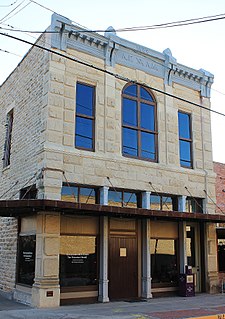
The Farmersville Masonic Lodge No. 214, A.F. and A.M. is a historic Italianate building located in Farmersville, Texas. It was constructed in 1888 as a meeting hall for Farmersville Lodge No. 214.

The Yell Masonic Lodge Hall is a historic Masonic lodge on the west side of United States Route 412 in Carrollton, Arkansas. Also known as Carrollton Masonic Lodge, it is a two-story wood-frame structure with a front-gable roof, clapboard siding, and a stone foundation. A small belfry rises above the roof, capped by a pyramidal roof. The building was built in 1876, originally serving as a church on the ground floor, and a Masonic meeting hall on the second. The building was a major community center for Carrollton, which was the first county seat of Carroll County but declined in importance after it was bypassed by the railroads.

The Indianapolis Masonic Temple, also known as Indiana Freemasons' Hall, is a historic Masonic Temple located at Indianapolis, Indiana. It was built in 1908, and is an eight-story, Classical Revival style cubic form building faced in Indiana limestone. The building features rows of engaged Ionic order columns.

The Old Masonic Hall, also known as Benicia Masonic Hall, is a historic building in Benicia, California.. Constructed by Benicia Lodge No. 5, in 1850, it was the first purpose build Masonic Hall in California. The first floor was used as the Solano County court room and offices, the second floor held rooms for the Lodge. The Masons occupied the building until 1887, when the Lodge outgrew the premises. The building was sold, became a public meeting hall until 1950, when the lodge repurchased the building. The building was listed on the National Register of Historic Places in 1972.

The name "Pythagoras Lodge No. 41, Free and Accepted Masons" is used by the National Register of Historic Places when referring to a historic building located in Decatur, Georgia. The building is also known as Pythagoras Masonic Temple and occasionally known as Decatur Masonic Temple. Built in 1924, the building is a work of William J. Sayward (1875-1945), an architect who was a member of the Masonic lodge, and who partnered with William A. Edwards in the firm Edwards and Sayward. It was designed and built in Beaux Arts architecture style.

Towanda Masonic Lodge No. 30 A.F. and A.M. is a historic building located in Towanda, Kansas, built in 1904. It was listed on the National Register of Historic Places in 2004.

The Masonic Hall in Waynesville, North Carolina is a historic Masonic Lodge constructed in 1927 as a meeting hall for a local area Masonic Lodge.
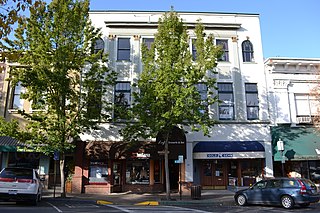
The Masonic Lodge Building is a historic building located in Ashland, Oregon. Constructed in 1909 as a meeting hall for a local Masonic lodge, it was listed on the National Register of Historic Places in 1992.
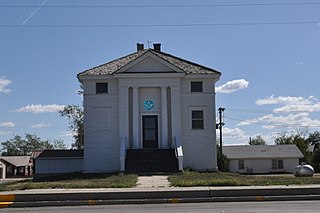
The Mt. Moriah Masonic Temple is a historic building in Kadoka, South Dakota. It was constructed in 1917, as a meeting hall for Mt. Moriah Lodge No. 155. The building was listed on the National Register of Historic Places in 2004 as Mt. Moriah Masonic Lodge No. 155. It has also been known as the Kadoka Masonic Hall.

Modale School and Masonic Hall is a historic building located in Modale, Iowa, United States. Built in 1880, the two-story frame vernacular form structure served as the community's school building. In general, 19th century school buildings resembled churches, and the Modale School was no different. The rectangular, front gabled building originally had a prominent bell tower that projected from the main facade. In 1911 the local Masonic lodge converted the building into a theater on the main floor and their lodge hall on the second floor. At that time they added a rear addition, Colonial Revival details on the main facade and on the porches, and Masonic symbols on the front gable end. The Modale lodge dissolved their membership in 2004 and merged with the lodge in Missouri Valley, Iowa as both had lost membership over the years. They donated the building to Town and Country Arts. It was listed on the National Register of Historic Places in 2014.

The Saratoga Masonic Hall is a two-story brick building in downtown Saratoga, Wyoming that houses Saratoga's Masonic lodge. Established in 1892, the lodge was the fourteenth to be established in Wyoming. After a time in rented space, the lodge bought the Couzens and Company Block in 1893, using the second floor for meetings and leasing the ground floor to storekeeper A. Johnson Dogget. From 1895 the ground floor was used as a school. The Masons allowed a variety of other organizations to use the building, including the Odd Fellows, Knights of Pythias, Pythian Sisters, Union Fraternal League, Modern Woodmen, Women of Woodcraft, Job's Daughters, the Republican Party and the Ku Klux Klan.

